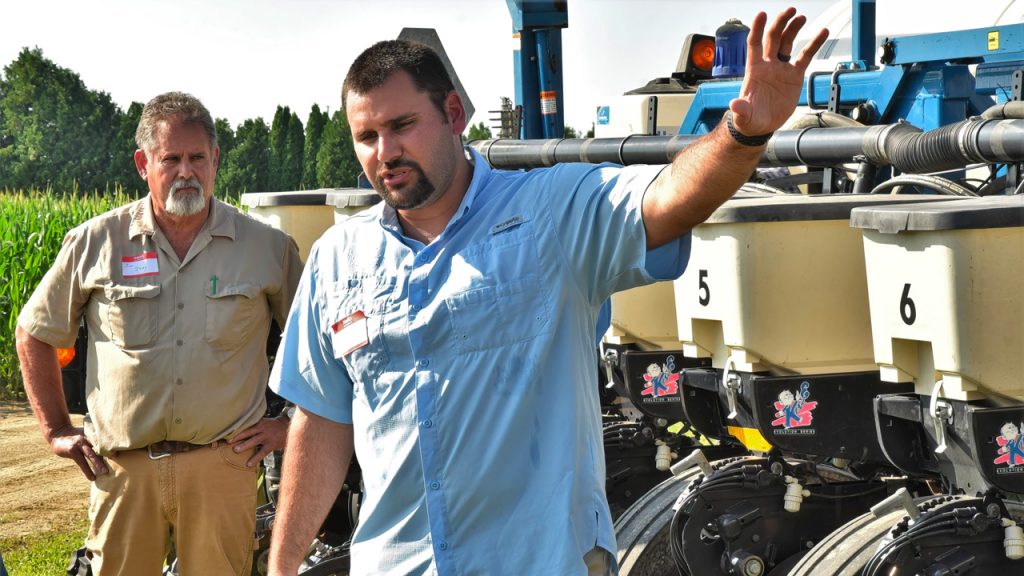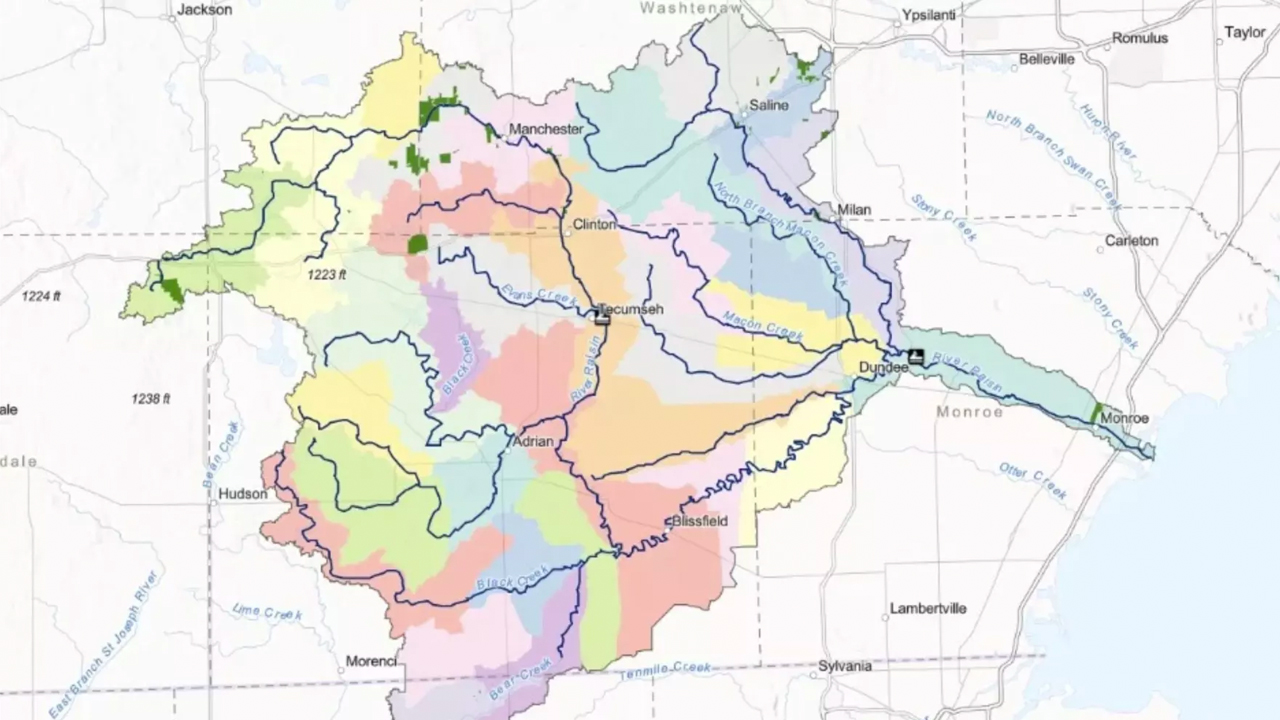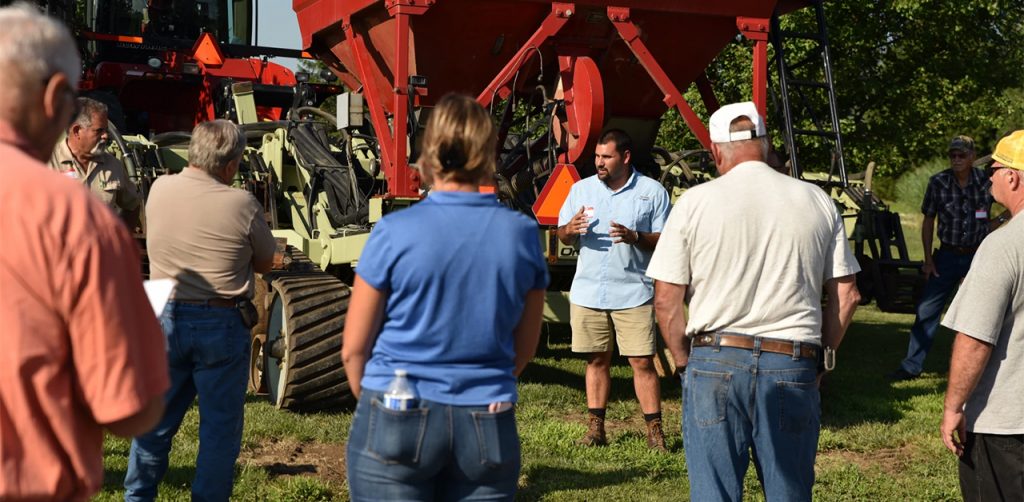Will Michigan farmers voluntarily help reduce phosphorus loading into Lake Erie?
Instead of plowing up the field every year, more progressive farmers are using no-till or low-till methods that don’t disturb the soil as much.

Jim Isley, left, and his son, Jake, right talk to other farmers about their experience in implementing low-till methods at their farm near Palmyra, Michigan.
A lot of people blame farms in Ohio for the cyanobacterial blooms in Lake Erie. Fertilizer runoff is blamed for the explosion of the harmful algal blooms. But, Michigan’s River Raisin also drains into Erie after passing through farmland in four counties. Michigan farmers are talking about what they should do, if anything.

One of the keys to reducing fertilizer runoff is soil conservation. Instead of plowing up the field every year, more progressive farmers are using no-till or low-till methods that don’t disturb the soil as much. It also means only putting fertilizer in the amounts needed in the spots needed. That means less gets washed into ditches and streams during heavy rains.
But only about one-third of farmers use no-till.
“Agriculture is no different than any other section of society. You’ve got your innovators, your early adopters, your mass that comes along,” says Joe Kelpinsky, program manager at the Michigan Department of Agriculture and Rural Development, “…and then there’s always going to be a percentage that are just aren’t going to do that.”
Kelpinski runs a program that recognizes environmentally friendly farms.
There are a lot of reasons why some farmers don’t or won’t give up plowing the fields.

Dan Moilanen, of the Michigan Association of Conservation Districts, organized a gathering of farmers on a farm near Palmyra, Michigan, to hear firsthand from people who have been using low-till methods successfully. It’s part of a new effort called Farmer-Led Watershed Conservation.
Moilanen says one thing that’s slowing the pace of change is that the average age of today’s farmer is 65.
“So you’ve got a lot of folks that are a little bit toward the end of their farming career and they don’t want to make that investment to adapt to these new practices.”
Some farmers have switched to no-till just because it makes sense to preserve soil and not pay for more fertilizer than necessary.
But, environmental concerns are becoming more pressing. Toledo temporarily shut down its water system a few years ago out of concern about toxins from larger areas of cyanobacterial blooms. Since then, public pressure to do something has been growing.
Bob Platt says he’s been totally no-till on his farm near Tipton, Michigan, for 13 years. He says most of the farms in his area are not.
“I think there’s a concern, but I think a lot of them are just blowing it off a little bit. And in reality, I mean, I hate to say that.”
Many of the Michigan farmers feel the problem is an Ohio problem because the drainage area into Lake Erie is so much larger in that state. They don’t feel Michigan farm runoff is enough to make any difference.
Platt adds some of them believe if there is a problem coming from Michigan, it’s because wastewater plants sometimes dump raw sewage into the rivers during heavy rains.
“In all honesty, that’s where I hear a lot of the people put the blame.”
The farm where this event is being held is owned by the Isley family. They call son Jake Isley the brains of the operation. He says he wants to use these conservation methods to make the soil better and reduce fuel consumption.

He says he also wants to do better for environmental reasons, but he thinks it’s a mistake to put all the blame for the cyanobaterial blooms on farming.
“Is it completely the problem? Absolutely not. There are a lot of factors that lead to that, that algal bloom. But as agriculture, I still think we have a lot of the solutions to be able to help fix some of those issues as well.”
For those farmers that are considering no-till or low-till farming methods there are obstacles. One big hurdle is having to buy different equipment. It can run into hundreds of thousands of dollars and there’s no guarantee that their harvests will be any better.
Dan Moilanen with the Michigan Association of Conservation Districts says that’s where government could help.
“We really need more state involvement in terms of the financing component. And I think making the federal process a little bit easier too will be great.”
Gov. Gretchen Whitmer wants a 40% reduction in phosphorus runoff that’s feeding the cyanobateria blooms in Lake Erie.
Low-interest loans and better incentive programs could make the difference in getting more farmers to go no-till and reduce that nutrient load.
In other words, Moilanen wants to see the state and federal governments offer more carrots, before using a stick.
“Eventually there may be a regulatory response to this, but if we can prevent that from getting to the point, if we can engage with those targets and reduce that phosphorus and that nitrogen issue, you know, we can we can hopefully prevent that from happening.”
Trusted, accurate, up-to-date.
WDET strives to make our journalism accessible to everyone. As a public media institution, we maintain our journalistic integrity through independent support from readers like you. If you value WDET as your source of news, music and conversation, please make a gift today.
